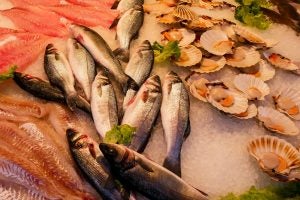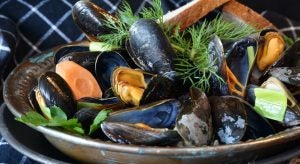How to prepare fresh, delicious seafood at home
Published 10:32 am Wednesday, March 14, 2018
BY ALETHEA PRICE
 Seafood has its place in southern kitchens, but often times you’ll find it fried. That’s not the healthiest way to prepare it but, yes — it sure is good …
Seafood has its place in southern kitchens, but often times you’ll find it fried. That’s not the healthiest way to prepare it but, yes — it sure is good …
Even in a land-locked state, we can get our hands on some pretty fresh seafood and prepare it in healthy ways.
We should eat more fish mainly because the health benefits. Seafood is a great source of protein, low in sodium and saturated fat. Diets high in seafood, especially fish with lots of omega-3s, have shown to be a great defense against Alzheimer’s.
There are many types of tasty things that fall under the category of seafood. There are three major categories: fish, crustacean and mollusk.
The breakdown
Fish can be even further broken down into fatty and lean varieties. Fatty fish, such as salmon and tuna, have larger amounts heart healthy good fats. Lean fish, such as tilapia, cod and catfish are lower in omega-3 fatty acid but are still a healthy choice. They’re also great because they tend to be a little more affordable.
Crustacean include shrimp, crawfish, lobster and crab. These can get pricy real quick. Mollusk include clams, mussels, oysters and scallops. I’m not sure if it’s true, you know, what they say about oysters. Feel free to test that theory on Valentine’s Day.
No matter what you’re cooking in the kitchen, it’s very important to keep food safety in mind. Here are some safe handling and selection tips for seafood.
• Shrimp: Fresh shrimp have a mild odor and firm-textured meat. The shell or meat is not slippery, and there are no black spots or patches on the shell or meat.
The shell of raw shrimp may be grayish-green, pinkish-tan or light pink. When cooked, the shell turns red and the meat takes on a reddish tint. Cooked shrimp have firm meat and a mild smell.
• Crabs, lobsters and crayfish: Live crabs, lobsters, spiny lobsters and crayfish move their legs. The “tail” of a live lobster curls under the body and does not hang down when you pick it up.
Frozen spiny or rock lobster tails have clear white meat, no odor and are hard-frozen. Cooked crabs, lobsters and crayfish have bright orange to red shells and are free of any disagreeable odor.
 • Clams, oysters and mussels: Purchase raw shellfish carefully. Buy raw clams, oysters and mussels only from reputable markets. If in doubt, ask the seafood market personnel to show you the certified shipper’s tag that accompanies “shell on” products or check the shipper number on shucked oyster containers.
• Clams, oysters and mussels: Purchase raw shellfish carefully. Buy raw clams, oysters and mussels only from reputable markets. If in doubt, ask the seafood market personnel to show you the certified shipper’s tag that accompanies “shell on” products or check the shipper number on shucked oyster containers.
Clams, oysters and mussels in the shell are alive, and the shells close tightly when tapped. Gaping shells indicate that the shellfish are dead and not edible. Shucked oysters are plump, and have a mild odor, a natural creamy color and clear liquid or “nectar.”
• Scallops: Fresh scallops have a sweetish odor and are free of excess liquid when packaged. The meat of the large sea scallop is white, orange or pink. Smaller bay and calico scallops are white, light tan or pinkish.
• Frozen seafood: When buying pre-packaged frozen selections, the flesh should be solid, and there is no discoloration or drying (freezer burn) on the surface. Odor is not evident or is fresh and mild. The wrapping material is moisture- and vapor-proof, fits closely around the product and is undamaged. Packaging materials do not contain ice crystals or have water stains or other indications that the product had thawed at any point.
Packaged breaded and un-breaded products have a clean and uniform appearance. Individual pieces separate easily, and the breading should be intact. Packaged frozen seafood may have an expiration date stamped on the label, which is important — use the seafood before the expiration date.
Methods of cooking
When it comes to cooking seafood, there are plenty of methods to choose from other than deep frying. Fish is the original “fast food.” It cooks quickly, within minutes, because it lacks the connective tissue of red meats and poultry.
Some of the best cooking methods for fish include poaching, broiling, grilling, baking and microwaving because they bring out flavor without adding fat.
You could even go a different route and skip the cooking process all together, but let’s get a handle on cooking seafood first.
• Guidelines for cooking fish: Cooked to perfection, fish is at its flavorful best and will be moist, tender and have a delicate flavor. In general, fish is cooked when its meat just begins to flake easily when tested with a fork and it loses its translucent or raw appearance. Like most foods, fish should be thoroughly cooked. The FDA suggests cooking fish until it reaches an internal temperature of 145 °F.
One helpful guideline is the 10-minute rule for cooking fish. Apply it when baking, broiling, grilling, steaming and poaching fillets, steaks or whole fish. (Do not apply the 10-minute rule to microwave cooking or deep-frying.) Practice makes perfect and cooking fish properly is all in the timing.
Here’s how to use the 10-minute rule: first, measure the seafood product at its thickest point. If the fish is stuffed or rolled, measure it after stuffing or rolling. At 450 °F, cook it 10 minutes per inch thickness of the fish, turning the fish halfway through the cooking time. For example, a 1-inch fish steak should be cooked 5 minutes on each side for a total of 10 minutes. Pieces of fish less than half an inch thick do not have to be turned over. Add 5 minutes to the total cooking time if you are cooking the fish in foil or if the fish is cooked in a sauce. Double the cooking time (20 minutes per inch) for frozen fish that has not been defrosted.
• Basic cooking tips for shellfish: Shrimp, crabs, scallops, clams, mussels, oysters or lobster become tough and dry when overcooked. Cook time for seafood is never anywhere near as long as most meats.
To cook raw shellfish, shucked or in the shell, follow some easy, basic guidelines. Raw shrimp turn pink and firm when cooked. Depending on the size, it takes from 3 to 5 minutes to boil or steam 1 pound of medium-sized shrimp in the shell.
Shucked shellfish (clams, mussels and oysters without shells) become plump and opaque when cooked thoroughly and the edges of the oysters start to curl. The FDA suggests boiling shucked oysters for 3 minutes, frying them in oil at 375 °F for 10 minutes or baking them for 10 minutes at 450 °F.
Clams, mussels and oysters in the shell will open when cooked. The FDA suggests steaming oysters for 4 to 9 minutes or boiling them for 3 to 5 minutes after they open.
Scallops turn milky white or opaque and firm. Depending on size, scallops take 3 to 4 minutes to cook thoroughly.
Place lobster in a pan of boiling water to cover, and return water to boil. Boil a 1-pound lobster for 10 minutes, and allow an extra 3 minutes for each additional pound. If steaming, allow 15 to 18 minutes for a 1½- to 2-pound lobster.
Some like it raw
Eating raw fish has become a little trendy in recent years. If you feel adventurous and want to try eating raw fish, there are a few things you should be aware of. It is safest to eat fish that has been thoroughly cooked.
If you choose to eat raw fish, selecting previously frozen fish is safer than fresh fish. Some species of fish can contain parasites and freezing will kill any parasites that may be present. Freezing will not kill all harmful microorganisms, so cooking is the safest method.
If you have questions or comments about the column, or if you’d like more information feel free to contact me by emaila.price@uky.edu.





